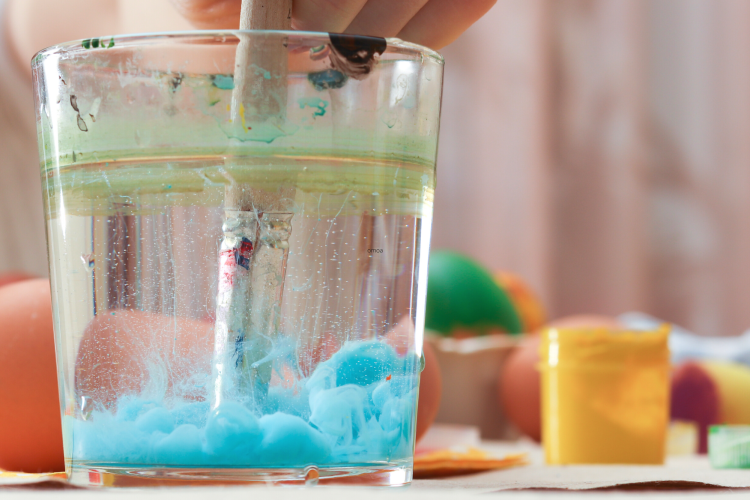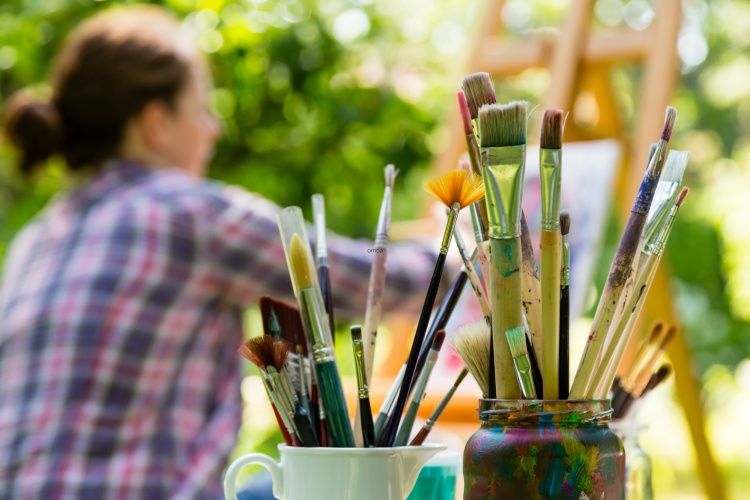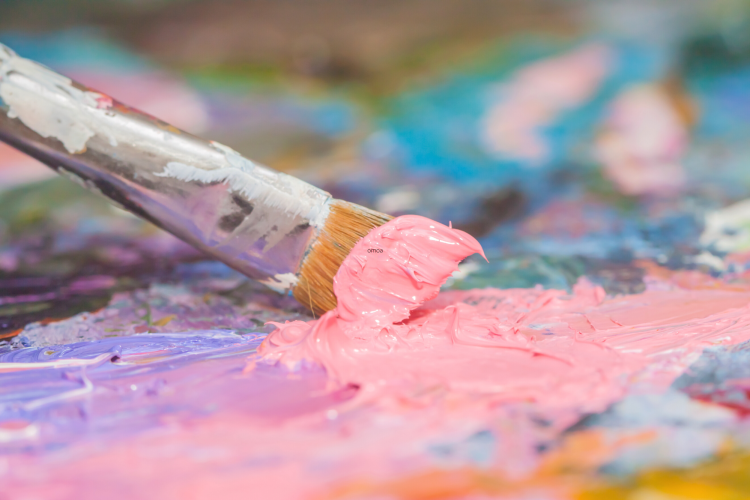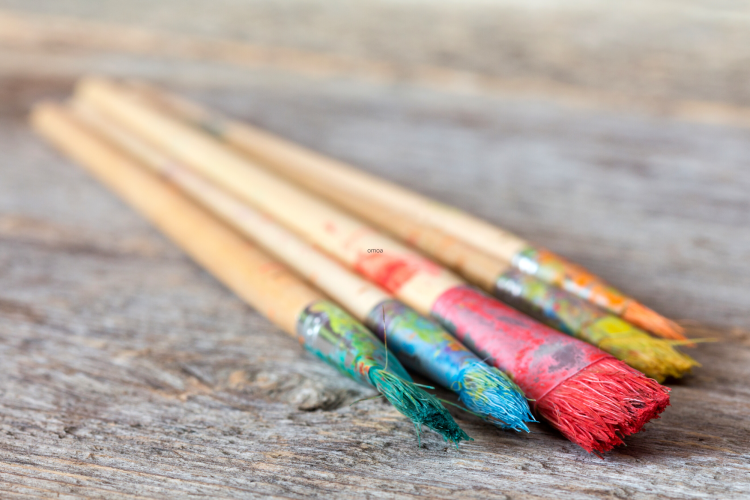How to Clean Paint Brushes for Best Results

The most important lesson for an artist to learn might be how to clean paint brushes! High-quality paint brushes can be very costly, and even lower-priced brushes add up when you build a useful collection.
Though it can be a tedious task at the end of a long painting session, the last thing a painter wants to do is replace brushes due to a lack of cleaning. So it’s vital to know the right methods for how to clean paint brushes, even if it’s your least favorite part of the painting process! The easiest way to prevent unnecessary replacements is to clean your brushes properly after every session.
So what should you know about how to clean paint brushes effectively? Is the process the same no matter what type of paint you use, or are there different methods for oil and acrylic paints? Our helpful guide will show you the ins and outs of how to clean paint brushes for long life and dependable use.
Jump to Section
- How Do Professionals Clean Their Paint Brushes?
- How to Clean Oil-Based Paint Brushes
- How to Clean Acrylic Paint Brushes
- How to Clean a Paint Brush With Vinegar
- How to Clean Paint Brushes With White Spirit
- How to Clean Dried Paint Brushes
How Do Professionals Clean Their Paint Brushes?
Guidance from an expert painter clears up any confusion that comes with knowing how to clean paint brushes the right way. No matter the medium they teach, painting instructors will include information about how to clean paint brushes before storing them between studio sessions.
Learn From an Expert
Learning from the pros is simple when you tap into painting classes. You’ll learn technique, materials and, of course, the proper process for how to clean paint brushes.
There are even online painting classes to help you perfect your craft and teach you how to clean paint brushes using the right methods for your medium.

How to Clean Oil-Based Paint Brushes
Solvents for Cleaning Oil Paint Brushes
Painting with oil-based paints brings your paint brushes into contact with linseed oil, pigment and thinner, all necessary elements in oil painting.
Knowing how to clean paint brushes using special chemical solvents like turpentine and mineral spirits helps you understand the chemistry of painting with oils, and is essential for oil painting for beginners.
These solvents are the most common for cleaning oil paint brushes and can be found in art supply stores for those interested in learning how to clean paint brushes with a solvent.
Some of these substances have strong fumes that may bother you, even when used in a well-ventilated area. If this is the case, other oils like mineral oil or olive oil can be used to release oil paints from brush bristles.
Is It OK to Clean Paint Brushes in the Sink?
When determining how to clean paint brushes for oil paints, the cleaner that’s easiest to find is grease-cutting dish soap. It’s affordable, available in any grocery store and is perfect for indoors use, all important considerations when determining how to clean oil paint brushes safely.
We recommend using a small bucket or bowl for the soap and water rather than soaking your paint brushes in the sink to keep paint and solvent chemicals out of the water supply.
How Long Do You Soak Oil Paint Brushes?
Time is a vital part of learning how to clean paint brushes effectively. Because oil paint dries slowly, it’s possible to wait for up to an hour before cleaning oil paint brushes.
If your painting requires you to keep your brush loaded between sessions, you can coat your brush with oil while it’s still loaded with paint without damaging the bristles. Your brush should only be kept this way for a day or two at the most; any longer and the paint could begin to dry, potentially ruining the brush.
In the event of oil paint hardening in your brushes, you can soak them in a solvent to let the paint break up over time. Test the bristles periodically to determine whether the paint is soft enough to be cleaned out of the brush. Once this happens, it can be cleaned like any other oil-based paint brush.
Cleaning Oil Paint Brushes With Turpentine or Mineral Spirits
If choosing how to clean your brush includes powerful solvents:
- Gently swirl the bristles around within the liquid to loosen the paint.
- Wrap your brushes in a rag or soft paper towels and work the paint out delicately until your brush is clean.
- Rinse your brush under water with a bit of dish soap to clean out the remaining solvent, condition the bristles and preserve their shape.
- Make sure they lay flat or stand upright once they’re clean; anything that presses against the bristles could compromise their shape.
Tip: When learning how to clean oil paint brushes with solvents, it’s important to remember that these substances should be used carefully to avoid unwanted splashes on your skin, your canvas and your work surface.

How to Clean Acrylic Paint Brushes
When working with acrylic paint, knowing how to clean brushes as you work can save you a great deal of time and trouble. When acrylic paints dry out, they can damage your brushes incredibly quickly, sometimes seizing up in your brushes before you even realize that it’s happened.
So, while acrylic paint is a more convenient paint medium to work with, it’s important to understand how to clean paint brushes for acrylics to avoid permanent damage.
Solvent for Cleaning Acrylic Paint Brushes
Acrylic paints are essentially liquid plastic suspended in water, which means the only solvent you need for cleaning acrylic paint brushes is more water, plus a little soap or brush cleaner to condition the bristles.
Whether your acrylic paint brushes are made of natural materials like sable or synthetic materials like nylon, they can all be cleaned with water and restored to their original state after regular use.
There are also brush conditioners that you can massage into the bristles to preserve them once they’re clean. This is an important detail when learning how to clean paint brushes. It can help extend the life of your brushes and keep them properly shaped and ready for use.
How Long Do You Soak Acrylic Paint Brushes?
How long you can let acrylic paint sit in your paint brushes without permanent damage depends on the temperature of your studio area.
A colder climate will keep acrylic paints wetter longer, allowing you to take more time between use and cleaning of acrylic paint brushes. A hotter climate can dry out acrylic paint in minutes, which gives you very little time to clean your brushes once you’ve finished painting.
The best approach when deciding how to clean paint brushes for acrylics is to soak them in a jar or brush basin filled with water when not in use to keep them wet until you can give them a full cleaning, preventing accidental drying and allowing you time to finish your work.
How to Clean Acrylic Paint Brushes With Water and Soap
The easiest technique to use when determining how to clean paint brushes used with acrylics is to wash them frequently in a jar of clean water. This allows you to swirl water through the bristles to eliminate paint without pressing or mashing them.
There are also brush bins with ridges at the bottom that led you gently scrub your paint brushes to help eliminate paint that may have been worked into the base.
Once the excess paint has been removed, give the bristles a rinse under clean water and add conditioner to keep them soft and supple. A drop of dishwashing detergent gently applied to the bristles afterward will help them maintain their texture and preserve their shape.

How to Clean a Paint Brush With Vinegar
Learning how to clean paint brushes safely sometimes means using household products like vinegar. Vinegar is a safe and natural food-based solvent that can help clean with both oil and acrylic paint brushes. Here's how:
- Because vinegar in its raw form can damage the gentle bristles in your paint brushes, its best to use a solution that’s one part vinegar and two parts warm water.
- Rather than soaking your brushes in this liquid, gently work the brush back and forth in the jar or bowl until the paint starts to release. Continue until the bristles are free of paint.
- Rinse the brush under warm water and add a bit of soap or conditioner to help keep the bristles soft and supple for your next masterpiece.
How to Clean Paint Brushes With White Spirit
White spirit, which is also known as mineral spirits, is a petroleum-based industrial solvent used for degreasing machinery. It can also be used as a thinner for oil paints…which means it can also be used by those practicing how to clean paint brushes of the oil paint medium.
It has properties that are similar to turpentine, but with lesser levels of toxic fumes and flammability.
If you’re wondering how to clean paint brushes using white spirit, the process is simple and familiar:
- Swish your brushes in a jar of white spirit, then drag them against a rag or soft paper towel to remove the paint.
- Rinse under warm water with a bit of soap or conditioner after a white spirit washing. This will keep your oil paint brushes in tip-top shape between uses.
- Keep a bottle of white spirit on hand for heavy-duty cleaning of stubborn paint that requires a little extra muscle, even if you don’t use it for regular paint brush upkeep.

How to Clean Dried Paint Brushes
Whether you paint with oils or acrylic paints, you may find yourself wondering how to clean paint brushes that have dried before you were able to clean them properly.
Can You Save a Dried Paint Brush?
One of the most important tips to remember when determining how to clean paint brushes that have dried is that there’s still hope for restoring them to their former glory! All it takes is a little patience and some chemical intervention to loosen the paint and get the bristles flowing again.
Solvents for Dried Paint Brushes
So, how do you clean brushes with dried paint on them? Since stronger solvents are called for in these situations, it’s best to keep a bottle of vinegar, white spirit or mineral spirits on hand when you need to figure out how to clean paint brushes you’ve let dry to the point of damage.
Tip: To prevent permanent ruin of the delicate bristles beneath the paint, try to clean the brushes actively rather than letting them soak in the fluids for too long.
How Do You Clean Brushes With Dried Paint on Them?
- Swirl the brush in a jar of the solvent, pressing gently against the bottom and sides of the jar to work the paint out.
- You may find it necessary to scrape the paint off once it’s been softened; use a thin blade for this to avoid tearing the bristles while separating them from the paint residue.
- Return the brush to the solvent and swirl again, repeating the process until the paint has dissolved and the bristles move freely.
- Once most of the paint has been released, rinse the brush under warm water and work the remaining paint out with gentle finger pressure.
Tip: Because this procedure can be extremely hard on your paint brushes, be sure to rub extra conditioner into the bristles once you’ve finished. This will give them their best chance of revival to a condition soft enough to be used for painting once again.
Even when it seems like a lost cause, there’s always hope when learning how to clean paint brushes!
Save Your Old Brushes
Despite knowing how to clean paint brushes, you may still find yourself with dried, bent or otherwise compromised brushes that can’t be fully cleaned. Don’t throw them away!
Most artists have a collection of less-than-perfect brushes that work perfectly for textures, effects and other artistic opportunities that call for an unorthodox touch.
Fur, grass, fabric and stone can all be rendered successfully with brushes that somehow escaped proper cleaning, and without fear of further damaging a brush that’s already in rough shape.


